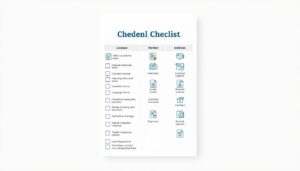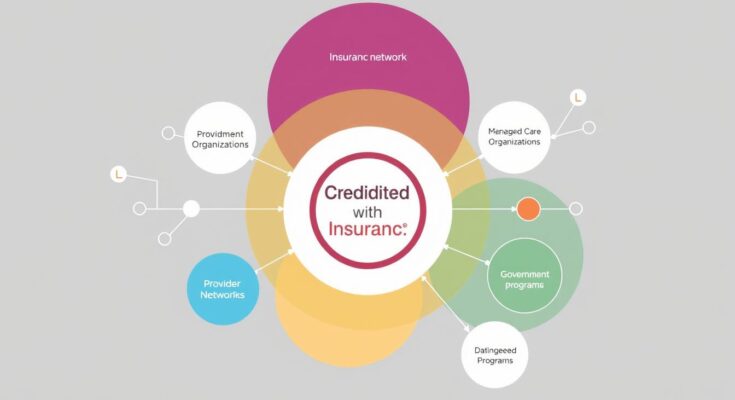As a healthcare provider, dealing with insurance credentialing can be tough. But it’s key for getting patients, getting paid, and growing your practice. So, you might ask, What does the insurance credentialing process involve, and how can I make it easier?
In this detailed guide, we’ll explore the world of insurance credentialing. We’ll cover the main steps, what you need to do, and how to do it well. This article is for both new and experienced healthcare providers. It aims to give you the tools to confidently move through the credentialing process.
Key Takeaways
- Understanding the importance of insurance credentialing for healthcare providers
- Familiarizing yourself with the key terms and definitions in the credentialing process
- Identifying the different types of insurance networks and their requirements
- Navigating the step-by-step process of getting credentialed with insurance companies
- Preparing the essential documentation and requirements for successful credentialing
Understanding Insurance Credentialing Basics

Getting into healthcare provider credentialing can seem tough. But knowing the basics is key for joining managed care networks and following payer contracting guidelines. We’ll cover the main terms, what they mean, and why credentialing is important for doctors and healthcare workers.
Also Read: Do You Need Freight Broker Insurance for Your Business.
Key Terms and Definitions in Credentialing
Credentialing checks if a healthcare provider is qualified and meets insurance and healthcare standards. You should know these terms:
- Provider Enrollment: The first step to join an insurance network.
- Recredentialing: A review of a provider’s credentials every 2-3 years.
- Payer: The company that pays for healthcare services.
- Contracted Network: A group of providers who agree to work at set rates for a plan.
Why Credentialing Matters for Healthcare Providers
Credentialing is vital for providers to get into insurance networks and get paid. It lets them:
- Join managed care networks and be seen as in-network.
- Follow payer contracting guidelines for timely payments.
- Show their skills and qualifications to patients and payers.
- Keep their reputation strong and follow industry rules.
Types of Insurance Networks
Providers face different insurance networks during credentialing, each with its own rules and benefits. Here are some common ones:
| Network Type | Description | Key Considerations |
|---|---|---|
| Preferred Provider Organization (PPO) | Offers a wide network with negotiated rates. | Patients can see in-network or out-of-network providers, but pay more for out-of-network care. |
| Health Maintenance Organization (HMO) | Provides care through a set network with a primary care gatekeeper. | Patients pay less when using in-network providers, but need referrals for specialty care. |
| Exclusive Provider Organization (EPO) | Like an HMO but with a smaller network and no out-of-network coverage. | Patients have less choice but pay less for in-network services. |
“Credentialing is not just a one-time hurdle; it’s an ongoing process that requires diligence and attention to detail.”
How to Get Credentialed with Insurance Companies: Step-by-Step Process
Getting credentialed with insurance companies can be tough and takes a lot of time. But, knowing the steps can make it easier. This way, you can meet the requirements and get credentialed successfully.
- Research and Identify Relevant Insurance Plans: Start by making a list of insurance companies you want to work with. Check their credentialing needs and rules to see if your practice fits.
- Complete the Credentialing Application: Fill out the credentialing form carefully, including all needed info and documents. Make sure to meet deadlines and follow submission rules.
- Gather Required Documentation: Collect important documents like your medical license, malpractice insurance, and education certificates. These are needed for your application.
- Establish a CAQH Profile: Make a detailed CAQH (Council for Affordable Quality Healthcare) profile. It’s a central place for your credentialing info.
- Submit the Application and Follow Up: Send in your complete application and any extra materials. Stay active by checking in with the insurance company to make sure they’re processing your application fast.
Also Read: Are Goldbacks a Good Investment – Expert Analysis Guide.
By following these steps, you can handle the insurance credentialing process and meet the provider enrollment requirements successfully. The main thing is to be detailed, organized, and keep going throughout the whole credentialing process.
“Credentialing is a critical step in ensuring your practice can provide care to patients covered by various insurance plans. It’s an investment of time and effort, but the payoff is well worth it.”
Essential Documents and Requirements for Credentialing
Starting the insurance credentialing process can feel overwhelming. But, having the right documents and information can make it easier. You’ll need professional credentials, liability coverage, and more for a successful application.
Professional Documentation Checklist
The credentialing application checklist is key. It makes sure you have all the important documents. This includes:
- Current curriculum vitae (CV) or resume
- Copy of medical license(s)
- Copies of board certifications and/or specialty certifications
- Copies of DEA and state-controlled substance licenses (if applicable)
- Professional liability insurance certificates
- W-9 tax form
- CAQH (Council for Affordable Quality Healthcare) profile information
License and Certification Requirements
Healthcare providers must keep their licenses and certifications current. This means verifying:
- Medical license(s) for the state(s) you plan to practice in
- Appropriate specialty or board certifications
- DEA and state-controlled substance licenses (if applicable)
Insurance and Liability Documentation
Having the right insurance is crucial. You’ll need to provide proof of professional liability insurance. This includes:
- Professional liability insurance policy
- General liability insurance policy
- Workers’ compensation insurance (if applicable)
By preparing all necessary documents, healthcare providers can confidently go through the credentialing process. This increases their chances of getting on insurance panels.
Common Challenges in the Provider Enrollment Process

Getting into insurance networks can be tough for healthcare providers. They face many hurdles when trying to enroll and keep their credentials up to date. This process is complex and takes a lot of time.
One big problem is all the paperwork needed. Providers must collect and send a lot of personal and professional info. This can be confusing and easy to mess up. Also, dealing with insurance companies can cause delays and problems.
- Incorrect or incomplete application submissions
- Difficulties obtaining necessary documents and licenses
- Slow response times from insurance providers
- Unexpected changes in credentialing requirements
- Challenges in maintaining active credentials and compliance
Another issue is the different rules for each insurance network. Providers have to learn and follow each network’s specific rules. This can be very time-consuming and may lead to mistakes.
| Common Credentialing Challenges | Impact on Providers |
|---|---|
| Inconsistent requirements across insurance networks | Increased administrative burden and potential for errors |
| Lengthy application review and approval timelines | Delayed patient appointments and revenue generation |
| Difficulty maintaining active credentials and compliance | Risk of being removed from insurance panels and loss of reimbursement |
To tackle these problems, providers should stay organized and communicate well. They should also be proactive in managing their credentialing. By keeping up with new rules and using technology, providers can make the process easier. Getting help from credentialing verification organizations (CVOs) can also be very helpful.
Also Read: When Does Gap Insurance Not Pay: Key Coverage Limits.
Preparing Your CAQH Profile and Maintenance
The Council for Affordable Quality Healthcare (CAQH) ProView system is key in the credentialing process. It’s vital for healthcare professionals to have a correct CAQH profile to join insurance networks.
Initial CAQH Setup Guide
To start, healthcare providers need to create a CAQH account and fill out the profile. They must give personal details, education, work history, and provider data verification documents. It’s important to make sure this information is right and complete. This is because it’s the base for all future credentialing.
Quarterly Attestation Requirements
- Healthcare providers must log into their CAQH account and do a quarterly attestation. This confirms their profile info is correct.
- This credentialing application checklist keeps providers’ credentials current. It helps them stay on insurance panels.
- Not doing the quarterly attestation can deactivate a provider’s CAQH profile. This can cause delays in the credentialing process.
Keeping a CAQH profile active and correct is a big part of the credentialing journey. By following the setup steps and doing the quarterly attestations, healthcare professionals can make the provider data verification and credentialing application checklist easier. This can help them get into insurance panels more successfully.
Timeline and Expected Waiting Periods
Getting through the insurance credentialing process can be tough for healthcare providers. Knowing how long it takes and what to expect is key. It helps manage expectations and ensures a smooth entry into managed care networks.
The time it takes to get through the process varies by insurance company. But, providers usually face a wait of 60 to 120 days. Sometimes, it can take even longer. This depends on how complete the application is, the insurance company’s workload, and how fast third-party verifiers respond.
- Initial Application Submission: This step usually takes 2-4 weeks. Providers need to collect all required documents and submit their application.
- Verification and Review: The insurance company’s team will then check the application and verify the provider’s credentials. This can take 4-8 weeks more.
- Final Approval: After verifying everything, the insurance company decides on the application. This can take another 2-4 weeks.
To speed up the process, healthcare providers can try a few things:
- Submit a complete and accurate application the first time.
- Keep records up to date and respond quickly to any requests for more information.
- Stay in touch with the insurance company’s credentialing team.
- Use a Credentialing Verification Organization (CVO) to help manage the process.
By knowing the usual timeline and preparing well, healthcare providers can make the credentialing process smoother. This increases their chances of getting into managed care networks successfully.
| Step | Approximate Timeline |
|---|---|
| Initial Application Submission | 2-4 weeks |
| Verification and Review | 4-8 weeks |
| Final Approval | 2-4 weeks |
“Patience and preparation are key when navigating the insurance credentialing process. By understanding the typical timeline and taking proactive steps, healthcare providers can set themselves up for success in joining managed care networks.”
Working with Credentialing Verification Organizations (CVOs)

Credentialing Verification Organizations (CVOs) are key in the world of provider data verification and insurance reimbursement. They make the credentialing process easier. This lets healthcare providers focus on their work while keeping up with insurance plan requirements.
Benefits of Using CVOs
Working with a CVO offers many benefits. These include:
- They handle all the data collection and verification, saving providers time and effort.
- They know how to deal with the different rules for each insurance network.
- They quickly process and send in credentialing applications, avoiding delays.
- They keep an eye on provider credentials, making sure everything stays up to date.
- They manage all the records and documents in one place, making it easy to find what you need.
Also Read: Principal Dental Insurance: Coverage You Can Trust.
Top CVOs in the Industry
There are many good CVOs to choose from. Here are some of the best:
| CVO | Specialties | Key Clients |
|---|---|---|
| CAQH ProView | Comprehensive credentialing and data management | Major insurance providers, healthcare systems |
| VerifPoint | Specialized in physician and allied health provider credentialing | Independent practices, multi-specialty groups |
| Aperture Credentialing | Full-service credentialing solutions for healthcare organizations | Hospitals, ambulatory surgery centers, medical groups |
Using the best CVOs can make the credentialing process much smoother. This means providers can get paid on time and work with more insurance plans.
Maintaining Active Credentials and Compliance
Keeping your credentials up to date and following payer rules is crucial. It helps you stay in managed care networks. Managing your credentialing well and following insurance rules keeps your care and income flowing smoothly.
Here are some tips to stay on top of your credentials and compliance:
- Timely Renewals: Watch the expiration dates of your license, certifications, and other important documents. Apply for renewals early to avoid any gaps in your credentials.
- Information Updates: Update your credentialing profile quickly with any changes. This includes new locations, services, or professional affiliations.
- Payer Guideline Adherence: Learn the specific rules for each insurance company you work with. Make sure you always meet their requirements.
- Ongoing Education: Keep up with payer policy changes, documentation needs, and industry rules. These can affect your credentialing and network participation.
By actively managing your credentials and compliance, you can make payer contracting easier. This protects your place in managed care networks. It ensures your patients get the care they need and your practice keeps earning.
| Key Credentialing Maintenance Activities | Recommended Frequency |
|---|---|
| License and Certification Renewals | As required by issuing authorities |
| CAQH Attestation and Profile Updates | Quarterly |
| Payer-specific Credentialing Requirement Reviews | Annually |
| Continuing Education and Training | Ongoing, as required by regulatory bodies |
“Maintaining active credentials and compliance is the key to ensuring uninterrupted patient care and revenue flow for your healthcare practice.”
Tips for Successful Insurance Panel Participation
Getting into insurance panels can be tough, but with smart strategies, healthcare providers can do well. Focus on clear communication and keeping your documents in order.
Best Practices for Communication
It’s important to talk clearly and often with insurance companies. Be quick to answer their questions and always be professional. Learn what each insurance panel needs to make the process smooth.
Documentation Management Strategies
Keeping your records in order is key. Create a system to keep track of important documents like licenses and insurance. Remember to follow up on deadlines to keep your credentials up to date. This shows you’re serious about following the rules and being professional.
FAQ
What is the insurance credentialing process for healthcare providers?
The insurance credentialing process is how healthcare providers join insurance networks. They need to apply, provide detailed information, and get verified by the insurance company.
Why is insurance credentialing important for healthcare providers?
Credentialing lets providers get paid for their services. Without it, they can’t get reimbursed, making it hard to keep their practice running.
What are the different types of insurance networks that providers can join?
Providers can join HMOs, PPOs, and managed care plans. Each has its own rules for joining and staying in the network.
What are the essential documents and requirements for the credentialing process?
Providers need to submit licenses, certifications, malpractice insurance, and practice details. A checklist helps ensure they have everything needed.
What are some common challenges healthcare providers face during the credentialing process?
Providers often face issues like wrong or missing information, slow verifications, and keeping up with insurance rules.
How can healthcare providers use the CAQH ProView system to streamline the credentialing process?
CAQH ProView is a platform for managing credentialing info. Providers can update their profiles to make the process easier with multiple insurers.
How long does the insurance credentialing process typically take?
Credentialing can take weeks or months. The time depends on the insurer, provider location, and application complexity.
What are the benefits of working with a Credentialing Verification Organization (CVO)?
CVOs help with credentialing by verifying info, submitting applications, and talking to insurers. This makes the process smoother and ensures compliance.
How can healthcare providers maintain active credentials and ensure compliance with insurance company requirements?
Providers must renew licenses, update info, and follow payer guidelines. This keeps them in good standing with insurance companies.
What are some best practices for successful insurance panel participation?
Good communication, efficient documentation, and proactive credentialing are key. Providers should also keep up with payer policy changes.



